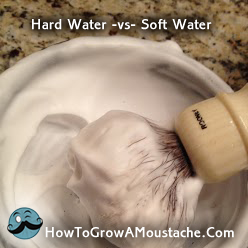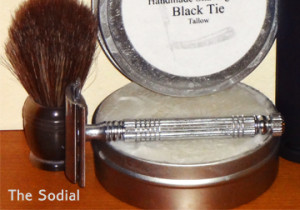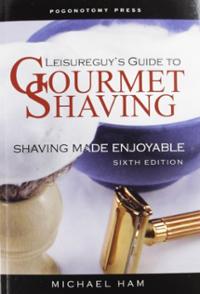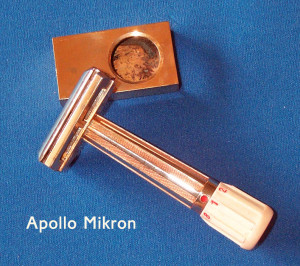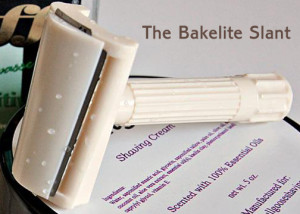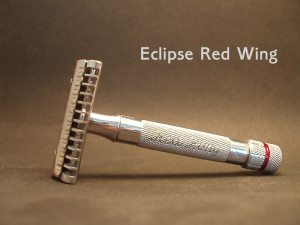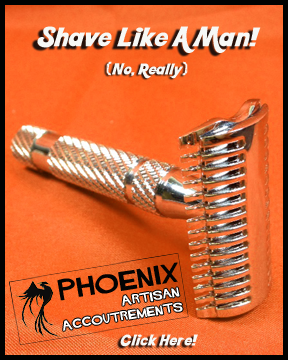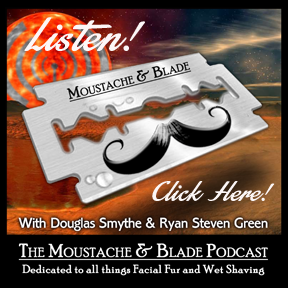[Be sure to check out our podcast interview w/ Michael Ham too!]
This week at How to Grow a Moustache we are finally getting to chat with Leisureguy Michael Ham. When it comes to wet shaving proper, Michael Ham practically wrote the book on it…oh wait, he did! In this interview Michael Breaks down many of the do’s and don’ts, dispels myths that have been in circulation for far too long in the forums, and generally just blows our minds. Michael’s approach to shaving is far from leisurely and we are very excited to have him as our guest today. Please enjoy this interview and be prepared to take notes (or bookmark). Shaving has suddenly become exciting…again. Enjoy!
HTGAM: Please Michael, for those that don’t know of you yet, or your book that changed the way most men now approach the daily shave, could you tell us who Michael Ham is?
Michael: I’m 73 years old, retired, and started shaving in the mid-1950’s with a Gillette Fat Boy. The only blades we knew were Gillette Blue Blades. I lathered only for the first pass, nicked myself a lot, hated shaving, and grew a beard as soon as I got to college. I wore a beard most of my work life. When I did have to shave, I used the cartridge razors of the time—and continued to hate shaving. Finally I stumbled across the renascence of DE shaving (through looking for information on a shaving brush), and have grown quite fond of shaving. I now shave daily save Sunday, and skip that day only to get a two-day stubble for the Monday shave.
HTGAM: One recurring theme I have come to find again and again when I get to chat or interview any of the big guns of the wet shaving world is that they all came to this by accident. Did you also just stumble into it? Could you have seen yourself doing this 15 years ago?
Michael: Not at all. 15 years ago I was going through a clean-shaven period, using cartridges with 3 blades, 4, 5… whatever was latest. And hating it.
HTGAM: As you may have gathered, our site is dedicated to facial hair, might you have any advice for the wet shaver growing and maintaining a moustache, burns, goatee, etc.?
Michael: I grew a full beard, but kept it trimmed short—though it was definitely a beard and not simply having missed shaving a few days, which seems to be a fashion now—to my generation that looks like someone pulled an all-nighter and had no time to shave. My mustache did not grow in well until my mid-20’s—my college beard was sans mustache. I mostly trimmed my beard myself, but one barber I went to did a very good beard trim and it always looked a lot better than I could do myself. That was in Iowa City a few decades ago.
HTGAM: I recently received an email from one of our readers who is African American. He suffers from ingrown hairs. He has been using a Mach (whatever number they are at), and that may be the problem right there. He wants to switch to a safety razor. What advice would you give him?
Michael: Prep is extremely important. Don’t rush it, and even try laying a moist hot towel atop the first layer of lather, letting it sit 2-3 minutes while you plan your day (or clean up around the sink), then remove, re-lather, and do the first pass.
Definitely pay attention to your beard’s grain: use this interactive diagram to map your beard. Wait 12-24 hours after shaving and feel your beard with your fingertip. The roughest direction at each point is against the grain at that point. Sometimes the grain is quite irregular, especially on the neck, where it may grow in whorls. With that sort of grain, you have to depend on good prep, though a slant-bar razor (The Slant Concept) can help—see this post. One important thing: never shave against the grain in areas in which you tend to get ingrowns.
I also recommend using an alum block as a regular part of the post shave routine: it’s mildly antiseptic and helps prevent skin blemishes.
Ingrowns are often a problem with any guy whose beard is curly: Celts, African-Americans, Mediterranean men, and so on. The problem is that curled stubble can easily curl into the skin. Shaving the right way can minimize that.
HTGAM: I recently did a review on a shaving puck for the Sharpologist, the soap was amazing, very rich, great glide and the lather was something else. Mark was inspired to try the soap himself. He didn’t not enjoy the puck, but his experience was definitely not the same. He thought this may have to do with the hard water in his neck of the woods. Can you explain how this works?
Michael: Hard water reacts with soap to form scum, a sticky compound that’s difficult to rinse from dishes, clothes, and yourself. People who are accustomed to hard water think that it’s difficult to rinse away soap using soft water. It’s not: the soap rinses off immediately, but since it doesn’t leave a sticky scum on the skin, the skin feels slippery. Hard-water users have always used the sticky scum as a sign the soap is gone. Without stickiness—and wet skin is normally slippery—they get the idea that soap is still present.
Soap scum is formed by minerals—calcium, mainly—that are dissolved in the water interacting with the soap. Since the minerals are dissolved, they can’t be removed by (say) a Brita filter, which removes only particulate matter. And bottled drinking water is typically hard water, which tastes better. If you have hard water (or think you might), try a distilled water shave as an experiment. For those using hard water, the difference is astounding.
A distilled-water shave is easier than it sounds because the volume of water needed for a shave is quite small. (In WWII GIs typically used half a canteen cup of hot water for a shave.) After a week of shaving with distilled water, you’ll have a routine that means you don’t have to think about it. Those who like cold-water shaves find it especially easy: they just use the room-temperature distilled water.
Shaving creams are more akin to detergents than to soaps and are less affected by hard water. This is what led to the idea that some brushes are “shaving-cream brushes”: good with shaving creams and not with soaps. A guy who has hard water finds that he can make a great lather from shaving cream, but when he uses a soap using the VERY SAME BRUSH, the lather’s terrible. So, obviously, that brush is good with shaving cream and not with shaving soap.
Wrong: the brush has nothing to do with it: it’s the water. I can get an instant great lather from any soap—including, say, Mitchell’s Wool Fat—using a soft, fluffy brush—an Omega silvertip—with no problem at all, but my tap water is relatively soft. Not so soft as (say) Vancouver or NYC, but soft enough.
HTGAM: I’m sure like most folks passionate about safety razors, you have more than one favorite. What razor, blade, soap, and brush did you use today?
Michael: I routinely blog (with a photo) my shave of the day.
Today I used:
- Whipped Dog 24mm silvertip brush
- AlsShaving.com Palermo shaving cream
- The Sodial $2.30 (including shipping) razor head on a Weber stainless steel Bulldog handle
- A Personna Lab Blue blade
- Musgo Real aftershave splash
I have a large collection of fine fountain pens, though I seldom use one nowadays, and when I was using them regularly, as I wrote with each pen I would think, “Ah! This one is my favorite.” The same is true with my shaving equipment and supplies. I weed out non-performers, so pretty much everything now performs quite well, though with differences: not differences in quality of performance, but in feel, personality, and so on.
HTGAM: Do you use any of the new modern scuttles? What is your opinion of them?
Michael: I never cottoned to scuttles, though I’ve had several. I made the usual mistake initially: using water that was too hot, which caused the lather to dry and shrivel. I worked that out, but I ultimately decided that scuttles were for me a hindrance to the smooth flow of the shave, plus they increased counter clutter, which was already pretty bad.
I build the lather directly on my beard (Here’s how I make lather), so I didn’t need a bowl, and standing the brush on its base worked fine.
The lather doesn’t cool much as I shave because nowadays my entire three-pass shave, from turning on the water for my pre-shave beard wash with MR GLO to splashing on the aftershave takes less than 5 minutes. (It was around 25 minutes when I first resumed DE shaving.)
HTGAM: Can you tell us about your book “Leisureguy’s Guide to Gourmet Shaving – Shaving made Enjoyable,” which is in its 6th edition during the time of this interview.
Michael: The book started as a letter to my son, in which I explained what I had learned and things I had tried. I posted that information on my blog and expanded and revised the post as I gained more experience and tried more things. The post grew to enormous size, and finally my son-in-law encouraged me to publish the content, rewriting it as a book.
I was dubious, but I did. The first edition was more a pamphlet than a book, but as I learned more, I expanded the book in subsequent editions. By the 5th edition the book was 142 pages and listed close to 100 on-line vendors who specialize in traditional DE/SR shaving. The 6th edition is 192 pages and lists over 120 vendors. It has become more comprehensive and also includes some digressions prompted by shaving thoughts and experiences, particularly the impact of shaving on other aspects of your life and psychology.
b. When people say all this information is available on the Web, I have to agree because the book itself is on the Web, in a way: you can download a Kindle version from any of the Amazons (.ca, .co.jp, .co.uk, .com, .com.br, .de, .es, fr., or .it). And of course you can get free Kindle-reader apps for the iPhone, iPad, your computer like the ones on black friday 2022, etc.
HTGAM: When I asked Mark Herro when he would be putting out a book he pretty much said you left him nothing to write about! You really crammed everything into that book, how long did it take to put together?
Michael: The first edition was almost 7 years ago. I have been coming out with a new edition each year, but I think the book now is close to what I had in mind. I accumulate notes during the year, and then it takes 2-3 months to incorporate those into the text and revise and expand my remarks for the new edition. So the total work it represents at this point is around two years of pure writing time, plus of course all the time doing research—i.e., shaving and trying various products.
I buy the products I use as a regular customer in order to avoid conflicts of interest, and I base my writing and conclusions on my own direct experience as well as observations of the experience of others. For example, my list of artisanal soaps and shaving creams contains only those that (a) I’ve used and (b) have worked well for me. Others I don’t mention, and of course there are many that I’ve not tried. But I’ve tried quite a few.
HTGAM: Bowl lather or face lather?
Michael: Here’s how I make lather. Be sure to load the brush well (and I didn’t realize for quite a while that I was insufficiently loading the brush). Once the brush is loaded, I go to my beard to work up the lather.
Bowl lathering seems to be popular with guys who use shaving creams, and I mostly use shaving soaps. When I began, I could easily get lather from shaving cream but had a hard time with shaving soap (despite our water being relatively soft). So I decided to put all the shaving creams aside and use only shaving soap until I learned to make a good lather. Once I did that, I found that, on the whole, I prefer lather from shaving soap to that from shaving cream—though I must say that the shaving cream from AlsShaving.com is almost enough to make me change my mind.
HTGAM: Some of our readers are collectors of vintage razors, myself included. Can you please tell us about some of your favorite pieces in your own collection?
Michael: I have about 60 razors, and since I get rid of those I don’t care for, I pretty much like all the ones left. Here are some highlights:
Apollo Mikron: A German adjustable razor that looks (to me) extremely cool. I searched for one for a few years before I bought this one (from eBay Germany). The Merkur Progress seems to me to be a cost-engineered version of the Mikron: simpler handle, etc., but the mechanism is much the same. At first I couldn’t get good shave—lots of nicks—to the point where I almost stopped using it—but it was so cool. So I would use it a week, then put it aside for a while. Finally, I learned it and it now is one of my favorite razors, comfortable and efficient.
That experience taught me a couple of things: first, you have to “learn” a new razor, and that may take a single shave or a week or two. Second, your skills with a razor can get better during the time you take a break from it. (William James discusses this phenomenon In Psychology, where he comments we learn to ice-skate during the summer and to bicycle during the winter—i.e, in the fallow periods.)
The iKon family: the first iKon razor—version 1.0—was extremely harsh to me, but Greg Kahn learned from that and iKon razors following that model has seemed exceptionally comfortable to me.
The Gillette adjustables—ver. 1.0 (Fat Boy), ver. 2.0 (Slim Handle), and ver. 3.0 (Super Adjustable)—are all favorites. The Super Adjustable (black handle, which comes in a short version as well as a long one) was the final model before the cartridges came along. All three are great. I began them at a setting of “3” and advanced the setting only as required for a good shave. Over a year or so I gradually moved to “5” and that’s where I remain.
The Tradere Solid Bar—the Tradere open-comb requires a very shallow angle (like the 2011 Mühle R41) and I didn’t like it since for me it came across as harsh (bad angle, I imagine). But the Solid Bar is very smooth shaving and comfortable.
The Bakelite slant—this is a Merkur slant made of white Bakelite. They are still occasionally available, either from someone selling one or as NOS. It’s probably my most comfortable and efficient razor, incredibly nice to use. Since it’s a slant, the light weight is an advantage, not a drawback: slants don’t need mass to drive the blade, and the light weight gives the shaver very direct control of pressure. The fact that Bakelite has low heat conductivity is also nice.
The Weber ARC (Advanced Razor Coating—a chromium-based coating often used on medical instruments) is no longer made, but I like it a lot. The current Weber (which I also like a lot) uses the same head design, but without the coating. The Weber, like the Tradere and the iKons is a stainless razor.
Feather AS-D1: another stainless razor, extremely comfortable and also extremely efficient.
Eclipse Red Ring: A very interesting vintage razor: it’s an open comb but has a reinforcing bar welded across the back of the teeth, which significantly strengthens them. Shaves well and has the nice touch of a little magnet in the base of the handle: makes it easy to pick up a blade on a countertop.
And of course, the (wonderful) Gillette vintage TTO razors: the Super Speed/Rocket family, and all the Aristocrats, Executives, Diplomats, Presidents, Ambassadors, and the like. I don’t much care for the Tech, but the TTO crowd is superb.
The Edwin Jagger/Mühle razors are the modern-day workhorses: absolutely solid shaves in a variety of handle designs.
HTGAM: The 1940’s Aristocrat on the cover of your book looks brand new; do you have any realistic cleaning/polishing tips for antique razors that you could share?
Michael: I did buy (for around $35) a 60-watt ultrasonic cleaner. (I was advised to get one of 50 watts or more.) Use room temperature water, and I recommend buying a cleaning solution specifically for ultrasonic cleaning rather than making do with detergent or the like: the special purpose cleaning solution does a better job.
Some of my treasured razors I sent out for replating. In the US, Razor Emporium and West Coast Razors offer a replating service; in the UK, Restored Razors does it. I had a couple of Fat Boys, a Gillette President, and a 1940s Super Speed plated in rhodium. The original plating was nickel, and the rhodium really makes those razors stand out: stunning. I also had a stainless steel Pils razor plated in gold, along with my stainless iKon version 2.0.
HTGAM: Finally, do you have any advice for the guys out there that are curious about the DE Razors but have yet to take the plunge?
Michael: You can move into DE shaving gradually by dividing the adventure into two steps, a month apart. Buy for each step only what you need for that step. This of course, splits the start-up costs into two separate months.
Phase I is prep: Everything until you pick up the razor. Purchases would be a good high-glycerin soap to use as a pre-shave beard wash, a decent shaving brush, a shaving soap, and shaving cream.
For a brush, the Ecotools Finishing Kabuki, a cosmetics brush, makes a terrific shaving brush, and you can find it for about $7.50 in the cosmetics section of a local Walgreens or the like (or from Amazon.com).
An Omega boar brush would also be good and not expensive—read the beginner’s guide to boar brushes for info on how best to use it. I like the Omega Pro 48 (model 10048), which runs less than $15. You must soak boar brushes before each use, but you can do that by simply getting the knot sopping wet and then letting the brush sit while you shower—that is, no need to fill a sink or cup to immerse the knot.
If you want an even better brush, a silvertip badger from Whipped Dog runs $26 including shipping; the 22mm size is a good all-round size. Or the HJM black synthetic, $25 including shipping from Connaught Shaving or Shaving.ie, is a wonderful brush.
The first month you learn good prep: wash beard with pre-shave soap after shower, work up a good lather, and lather your beard before shaving. You may find it difficult to get a lather from shaving soaps. If so, suspect hard water and try a distilled water shave using the procedures at the link—using distilled water offers a diagnosis and possible workaround. The difference can be astonishing.
Also work out the grain of your beard and start doing two passes, trying not to press hard: one pass with the grain, one pass across the grain. Lather before each pass. You can use this interactive diagram to map the grain of your beard.
Then the next month do Step 2: Shaving and aftershave.
Buy a DE razor, a blade sampler pack (and please read this post on how to use the sampler pack effectively), an alum block (post-shave skin treatment), and a liquid styptic in case you get cut or nicked. I like My Nik Is Sealed, but Clubman Pinaud Dab-On Styptic and Pacific Shaving’s Nick Stick are also good.
For a razor, I recommend theSodial on Amazon.com ($2.30 including shipping) or one of the Edwin Jagger DE8x line if you want a more traditional razor—the DE86bl (faux-ebony handle) runs about $30. All the EJ razors have the same head, so just choose a handle that you like. Both MaggardRazors.com and ItalianBarber.com sell DE razors for around $20 that also can be used. The Sodial, however, is surprisingly good, particularly if you substitute a better handle.
You already know prep, so now you learn to shave. The guard is the part of the baseplate that extends outward under the blade—the guard may be a straight bar or it may be an open-comb (with spaces between blunt teeth). Don’t give the guard any of your attention—just ignore it. If the novice focuses his attention on the guard, he will generally get too steep a blade angle, thus scraping his face, which produces razor burn. The guard is there if it’s needed, so you don’t have to think about it.
Put your attention instead on the edge of the cap, and then the angle will take care of itself. The cap of the razor is the curved top that holds the blade against the baseplate. If you put the top of the cap on your skin, the handle sticks out at right angles and the blade’s edge is above the skin. Lower the handle just until the blade touches the skin. Keep the edge of the cap (just behind the blade’s cutting edge) in contact with the skin, but NOT pressing the skin enough to indent it: just touching the skin. Try to use too little pressure: imagine you’re shaving a balloon. This combination—edge of cap touching the skin (for angle) and just barely touching the skin, not enough to indent it (for pressure)—will minimize cuts and eliminate razor burn. (If the cap is not in contact with the skin at all, so that the razor is riding on the guard, the angle is too steep and razor burn will result, along with nicks.)
Keep the bathroom silent (no fan, no radio, no running water) and use the sound of the blade cutting the stubble to tune the angle.
Guys who have already established their shaving habits from using multiblade-cartridge razors will find that they automatically tend to hold the razor with the handle close to their face. With a DE razor, this puts the guard on the face and the blade at a steep angle, scraping the skin and causing razor burn.
With a DE razor the correct angle puts the handle far from the face (to keep the cap edge on the skin), which feels quite strange to someone accustomed to a cartridge razor, and often his muscle-memory will lower the handle (which puts the guard firmly on the face, increasing blade angle). The only way to avoid this is to pay careful attention while you’re shaving. (In much the same way, muscle memory of the pressure required by cartridge razors leads novices to use excess pressure with a DE razor.) Eventually, of course, new habits are established.
Note the four most common mistakes cartridge shavers make when switching to a DE razor.
A very special thanks to Michael Ham for taking time out for us! To learn more about Leisureguy Michael Ham you can find him on The Sharpologist or at his own blog Leisureguy and if you have not already done so, please do yourself a favor and check out Michael’s book Leisureguy’s Guide to Gourmet Shaving – Sixth Edition: Shaving Made Enjoyable (here is what people are saying about it).
Interview by Douglas Smythe
Don’t forget to enter our Monthly Giveaway for a chance to win a Vintage Gillette and More! For more info visit Monthly Giveaway




